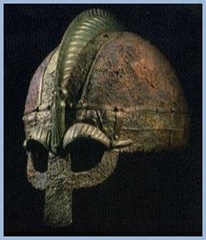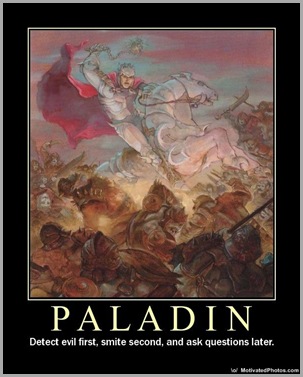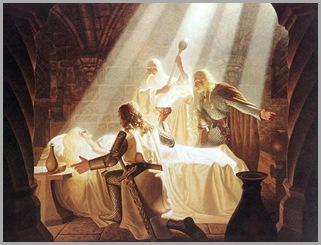 I’ve been digging through my old files (both paper and electronic) and have realized at some point I revised my initial rule-set. Both of the Garhelm campaigns were played over four years ago (egad, time flies), so I’m not certain when certain rules were in effect. I am fairly certain those in my first rules post were used consistently. I’m not sure about the following ones, unless otherwise noted below. In any event, here are a few more rules, again with annotation.
I’ve been digging through my old files (both paper and electronic) and have realized at some point I revised my initial rule-set. Both of the Garhelm campaigns were played over four years ago (egad, time flies), so I’m not certain when certain rules were in effect. I am fairly certain those in my first rules post were used consistently. I’m not sure about the following ones, unless otherwise noted below. In any event, here are a few more rules, again with annotation.Detect Chaos/Evil/Good/Law
- The detect chaos/evil/good/law spell and similar spell-like abilities do not function in regard to sentient beings. What is evil to one may be not be evil to another. However, the spell does function for insentient entities, such as magic weapons or locations, because such effects are typically a function of magic.
- From a gaming standpoint, detect chaos/evil/good/law and similar spells and abilities often rob role-playing encounters of their worth.
- [I believe this rule was used throughout both campaigns. I have never liked the problems that result from this spell. On one hand, it makes things easier: “If it’s evil, we kill it.” On the other hand, it makes things more complex:“Is it really a good action to kill an evilly aligned orc child?” or “Is it really a good action to harry any NPC in the bar that detects as evil?”
 Given that I did not mention *protection* from chaos/evil/good/law spells in the rules, I likely let them work normally. I might tweak that and let such spells work only for outsiders or other beings that are inherently tied to their alignment. For example, a demon is in a sense Chaotic Evil incarnate, so it seems logical that wards against a demon should work. A gnoll, on the other hand, is more of a natural being and not inherently evil from birth.
Given that I did not mention *protection* from chaos/evil/good/law spells in the rules, I likely let them work normally. I might tweak that and let such spells work only for outsiders or other beings that are inherently tied to their alignment. For example, a demon is in a sense Chaotic Evil incarnate, so it seems logical that wards against a demon should work. A gnoll, on the other hand, is more of a natural being and not inherently evil from birth. - Quite frankly, I’m ready to pitch alignment altogether. It feels too forced and it seems players and DMs always find a rationale for a character’s/NPC’s action, regardless of his alignment. Polymythic Steve and I had an interesting IM chat a few weeks back about alignment. One of these days I’ll get around to blogging about it, but it started from this question: “In a democracy, if you can detect evil, should evil people be allowed to vote?”]
Raise Dead [I had two versions of this rule, both are included below.]
- [Version 1] The raise dead spell is available, but has been modified. A raised character does not lose a character level, but instead, as with previous editions, loses a point of Constitution. If the character’s Constitution reaches zero, he cannot be raised. The material component for raise dead is no longer a 1000 gp diamond. Instead, the caster must sacrifice a quantity of magic items relative to the strength of the character’s soul (i.e., his level). There is not a hard and fast rule regarding the proper sacrificial amount. The DM will use his discretion in such matter.
- [Version 2] The raise dead functions as described in the 3.5 Player’s Handbook except for the material component. Instead of a 5000 gp diamond, one or more willing participants much sacrifice some of their life force to restore the life of the recipient. In game terms, they must sacrifice a total of XPs equal to the minimum XP for the recipient’s former level (i.e., before the level loss of being raised). For example, to raise a 2nd level character, four PCs would lose 500 XP each. Note: each participant must sacrifice an equal share. The caster can choose to participate in the sacrifice, but can only do so if the XP loss would not cause him to lose access to the raise dead spell.

- [At the time I believed players weren’t sufficiently penalized for PC death and I didn’t like the whole concept of buying back your dead. Version 1 also doubled as a handy way to ensure the party didn’t become overly loaded with magic loot. I quite like the role-play concept of Version 2: the party giving of its own life to bring back the dead makes more sense (in a fantastical way) and is a much greater sacrifice than loot. On the other hand, it sort of feels like that scene in Full Metal Jacket where the rest of the troop is punished for Private Pile’s actions (NSFW link). I’ve come full circle on raise dead and now make it fairly easy for players to bring back the fallen (see my current house rules). I’ve embraced the “game” part of “role-playing game” and don’t sweat it.]
- If a PC dies and cannot be raised or resurrected, the player must roll a new PC. To ease matters for the gaming group (DM and players alike), the new PC will start at 2nd level. The PC will receive the standard HP for first level (i.e., maximum), but must roll his 2nd level hit die in the DM’s presence. The PC will begin with the standard 1st level starting money for his class.
- [I’m not sure what this was about because I can’t remember what level the PCs started at.]
- All die rolls that fall off the table must be re-rolled on the table. No exceptions.
- If a rolled die comes to rest without a discernable result (e.g., the die lands in a crack on the table, etc.), the die is to be re-rolled. No exceptions.
- [This might seem like overkill, but I include this in my house rules to this date.]
- [I don’t remember anyone actually using these points. It seems like the players kept saving them for a rainy day that never happened. Again, although I originally had some house rule luck points in mind, I opted for what I now consider overly complex official rules. If I ever wanted something like this again, I’d just let the players earn luck points for good game play and let them use it to re-roll a die roll.]
- Characters gain a number of action points equal to 2 + one-half their character level, rounded down, at 1st level and every time they attain a new level.
- Action points provide characters with the means to affect game play in significant ways. A character can spend 1 action point to alter a single d20 roll used to make an attack, a skill check, an ability check, a level check, or a saving throw.
- When a character spends 1 action point to improve a d20 roll, add 1d6 to the d20 roll to help meet or exceed the target number. A character can declare the use of 1 action point to alter a d20 roll after the roll is made—but only before the DM reveals the result of that roll (whether the attack or check or saving throw succeeded or failed) [I find this bit particularly lame. It turns into a game of How Well Can the Players Read the DM’s Reaction]. When possible, the player should state his intention to spend an action point before the die is rolled. For example, “I may use an action point on this attack roll.”
- A character can’t use an action point on a skill check or ability check when he or she is taking 10 or taking 20.
- A character can only spend 1 action point in a round.
- Depending on the character level (see the table below), he or she may be able to roll more than one d6 when spending 1 action point. If the character does so, apply the highest result and disregard the other rolls.
| Character Level | Action Point Dice Rolled |
| 1st – 7th | 1d6 |
| 8th – 14th | 2d6 |
| 15th – 20th | 3d6 |

No comments:
Post a Comment